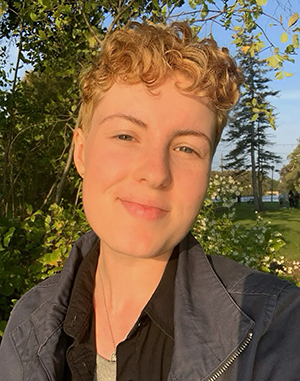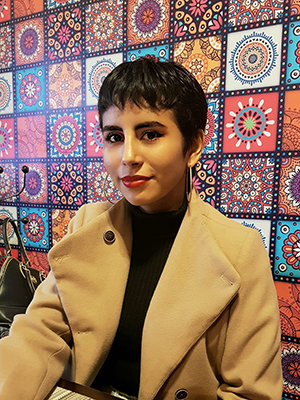Symbiosis: Fernanda Solorza interviews Kaye Miller

Volunteer Fernanda Solorza talks with Kaye Miller, whose story "Telling the Bees" appears in our winter issue #225. They discuss beekeeping, story as ecosystem, and how distance from a piece can bring clarity.
Read an excerpt from "Telling the Bees" here.
Kaye Miller grew up on the traditional territories of the Blackfoot, Îyâxe Nakoda, and Tsuut’ina nations in Calgary, Alberta. They love dinner parties, giving book recommendations, and collecting beach glass. Their work can be found in Plenitude, Grain, The Ex-Puritan, Vagabond City Lit, and elsewhere. They hold a BFA in Writing from the University of Victoria and are an MFA candidate at the University of Guelph, where they are working on a novel about lesbian rodeo princesses.
“Telling the Bees” beautifully explores themes of transition, commitment, and interconnectedness. Can you elaborate on the choice of using beekeeping as a metaphor for the characters' experiences and growth? How did the previously mentioned themes of the narrative align with your overall intentions for the story, and were there specific real-life inspirations that influenced the thematic elements?
I have found that when I write short stories there has to be an element that I am captivated by—something I love that I can research and then infuse with story. I love a good metaphor, and I love going down the rabbit hole of research—that love is what commits me to a piece. It’s intrinsic to my creative process. In the case of “Telling the Bees,” I have always had an interest in beekeeping. I have family who keep bees in their backyard and have been captivated by all the stories they’ve shared of caring for the hive throughout the year. There’s a personal, almost familial relationship between the hive and the beekeeper—a great deal of attention and care is essential to the keeping of bees. As I wrote “Telling the Bees” I was delighted by how the bees could function as a metaphor for family, and for the mutual commitment that the narrator and Ellis are making to each other and their shared life.
The characters exhibit a depth of emotion and tenderness, especially in their romantic relationship, and the new dynamic both characters have with the bees. How do you approach character development, especially in portraying the nuanced emotions of grief and guilt when facing challenges in the hive, and by extension, life? Additionally, can you discuss the significance of the narrator's evolving self-perception, particularly concerning their changing gender identity and the dynamics of their relationship with Ellis?
The characters in this piece really came to me as I wrote, developing in response to the world. There is a symbiosis between their behaviours and their environment which made writing them fairly easy—they are exactly who they need to be. In this way, I think story functions as an ecosystem, with characters filling an ecological niche. It felt natural to me to have Ellis be the beekeeper and the caretaker—the love and willingness to learn that he has with the bees is the same love and willingness he shows in his relationship. The narrator, on the other hand, is more guarded, to protect themself and Ellis. At a base level, their response to the bees is the same as their response to the world—its misunderstandings, its potential threats. They are learning to be more comfortable in themself, in the way their relationship is perceived. It is Ellis who encourages them to become more open, to see things through a naturalistic, even hopeful lens. The nuance in these characters and their emotionality comes from the natural factors of their environment—the bees, the changing shape of their relationship, and the world’s response to it. Their grief and joy and love are all inherent to their situation.
The story has a compelling narrative structure, with a seamless blend of the narrator’s personal reflections, factual information about beekeeping, and emotional moments. Could you discuss the decision-making process behind this narrative structure? How did you balance the informative aspects with the emotional journey of the characters, and did you face any challenges in maintaining this balance throughout the piece?
It's a bit hard to track the timeline of choices with “Telling the Bees”—it came together as somewhat of a fluke. In terms of active writing time, this was perhaps one of the easiest writing processes I’ve had. I started the story in the summer of 2022, then picked it up again last spring, after finishing my first year of grad school. I wasn’t sure when I put it down if I’d come back to it, but the distance away gave me the perspective to see what the story needed. There were many threads in the original draft that I had been struggling with the first time around—I ended up removing these when I came back to it. Those threads helped develop the characters and their relationships, but in the end, they weighed down the piece. I think the story stands stronger in its current simplicity, but this couldn’t have been achieved without the earlier exploration. I think many of the best stories can come this way—in the unbridled exploring and then the paring down to the essentials. The distance and time I took from the piece brought it clarity, and the balancing of the different elements of character, facts, and emotion came naturally with that.
Delving into your writing process, can you shed some light on your routine or habits? Do you have any specific rituals or approaches that help you get into the creative mindset? Additionally, considering the immersive details and emotional resonance in your writing, how do you navigate the balance between factual accuracy, personal reflection, and imaginative storytelling in your works?
I’m fairly erratic when it comes to my writing process(/es)—I can get into a regular routine for some time, working on one specific project, but then I’ll go into a writerly hibernation. I’ve become more comfortable with this somewhat seasonal cycle of creativity, though there’s always a bit of guilt when I’m not being “productive”—unlearning that might take a lifetime. When I am working with deep concentration on a piece, I do try to immerse myself in the details of it—as well as research, I love to make a visual mood board, a playlist. Sometimes I’ll change my laptop’s wallpaper. There’s always a lot more going on beneath the surface that the reader will not see, though I do believe the research and immersion come through in subtle ways—especially for a quiet piece like “Telling the Bees,” where so much of the emotion and metaphor of the piece is buried in those details.
Since the publication of this captivating piece, could you share any current projects or creative endeavors you are currently involved in? Are there particular themes, genres, or subjects that have captured your interest lately, and how do they compare or contrast with the themes explored in “Telling the Bees”?
I’m now in the last year of my MFA, so I’m hard at work on my thesis, which is a novel about queer rodeo princesses getting into trouble at the Calgary Stampede. It’s a lot bigger and flashier than “Telling the Bees,” which occasionally has me yearning for simplicity, but it’s still a rollicking good, gay time. It also has that thread of prairie in it that hits close to home for me, and of course, that element of research and fascination that carries me through a piece.

Fernanda Solorza









